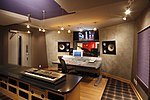The Ambassador Theatre is a Broadway theater at 219 West 49th Street in the Theater District of Midtown Manhattan in New York City. Opened in 1921, the Ambassador Theatre was designed by Herbert J. Krapp and was constructed for the Shubert brothers. It has 1,125 seats across two levels and is operated by The Shubert Organization. The auditorium interior is a New York City designated landmark.
The theater is oriented on a diagonal axis, maximizing seating capacity on its small site of 100 by 100 feet (30 by 30 m). The facade is largely made of golden brick and is simple in design. The most prominent part of the facade is a curved entrance at the southeast corner, facing Broadway, where a lobby leads to the rear of the theater's orchestra level. The auditorium contains Adam-style detailing, a large balcony, and box seats with decorated arches above them. The auditorium contains a segmental proscenium arch topped by a curved sounding board.
The Shuberts developed the Ambassador, along with the neighboring O'Neill and Walter Kerr theaters, after World War I as part of a theatrical complex around 48th and 49th Streets. The Ambassador opened on February 11, 1921, with the musical The Rose Girl. The Shuberts sold the property in 1935, and it was intermittently used as a CBS broadcast studio, a movie theater, and for live theater until 1945. The Ambassador then hosted foreign films in the late 1940s and was a studio for the DuMont Television Network in the early 1950s. In 1956, the Shuberts assumed ownership again, returning it to use as a live theater. Though many of the Ambassador's productions in the 20th century were short runs, it has hosted since 2003 the musical Chicago, the second-longest-running Broadway show as of 2021.











